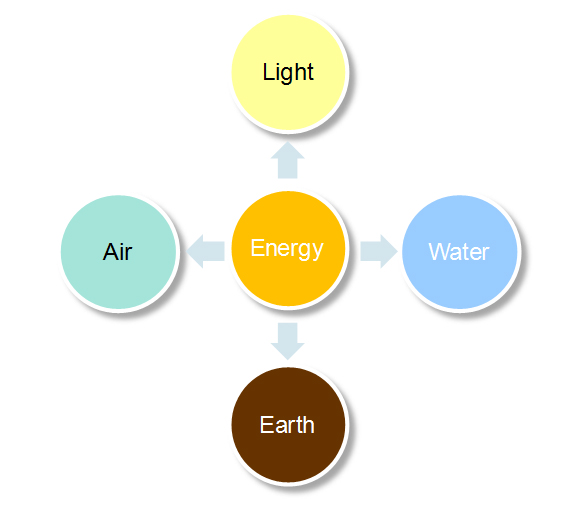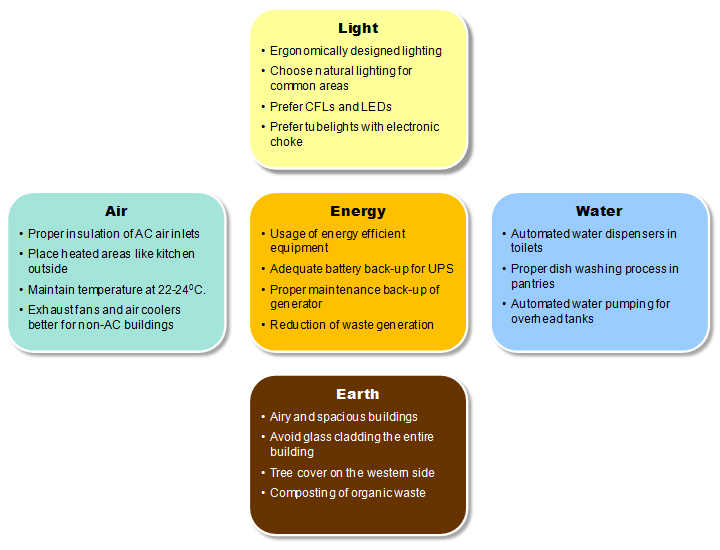The simplest way to find out is to do an energy efficiency exercise at our offices. Is it as simple as switching off all lights and fans when not in use? No, energy consumption and wastage happen both when electrical equipments are in use as well as they are in standby mode. In fact energy efficiency is much more than just electrical power. It is to do with fuel, water, air and food as well.
We have devised a simple theory of energy efficiency by utilising the ‘Panchabhootas’ the five basic elements of Hindu mythology. We can find out the eco-friendly quotient of your offices by checking on these elements –
Guide to energy efficient office
- Air – circulation of fresh air and the power usage to supply fresh air
- Water – amount of water consumed for daily activities and the energy used to pump water
- Energy – energy used for power, lighting, cooking, heating and other purposes
- Light – usage of artificial lighting and the energy efficiency of lighting
- Earth – building material used for constructing the building
- The first thing to inspect is the proper insulation of all air inlets and outlets in an AC building. For instance, the copper tubes that bring in the cool air inside should be packed tightly with plastic foam insulation. Similarly the heat ducts should be correctly ventilated.
- Close all holes where air could escape so that the cool air remains confined inside. All AC buildings must have insulated glass doors with automatic door shutting mechanism.
- A typical mistake is to place heated areas such as kitchen and pantry inside the central AC zone. Efforts should be made place these areas in open spaces with natural airflow.
- Some areas inside the building get heated up faster while some areas are cold. One reason for this is the building’s orientation towards the sun.
- Simple solution is to avoid glass covering on the western side to prevent heating or to have double glazing of the glasses to ensure thermal insulation.
- Finally, maintain the ambient room temperature at an optimum level of 22-240C.
- For non-AC buildings, air cooler is the best option since it moistens and cools the air it pumps in. Fans are not a good option since they tend to circulate the same stale air. We need to ensure to keep windows open to let in fresh air. Exhaust fans are the most efficient way to pump out stale and hot air.
Water
Water consumption in offices is another aspect where energy can be conserved. However, Wastage of water happens because of two main reasons: habits and negligence. Mainly water wastage happens in toilets and in pantries.
- Automated water dispensers should be installed in toilets to ensure adequate cleaning and optimal water usage.
- Proper dish washing process needs to be managed to ensure optimal water usage in pantries.
- Overhead tanks need to have automated water level indicator to prevent overflow or empty run.
Energy
Consumption of electricity and fuel is considered as energy usage. The simplest way to cut down energy usage is to plan your office activities so that peak energy usage can be reduced.
- Diesel fuel for backup generator is the largest energy component in any office. Proper maintenance and operations of the generator is crucial to reduce fuel wastage. Automated switching of power between mains and backup is essential.
- Most power outages are usually between 10-15 minutes so it is better to provide power through UPS with adequate battery back-up to power all the appliances at office. Intense power consumers such as AC and elevators can be kept out of the UPS coverage.
- Usage of energy efficient equipment is crucial. Check for energy star rating for your PCs, AC, fans, lighting and other appliances.
- Large campuses can make efforts to generate biogas from the human waste and composting of food and other organic waste.
Light
It is near impossible to utilise natural lighting in all corners of office buildings. However, efforts should be made to utilise as much sunlight as possible. In artificial lighting, the type of lighting matters.
- Ergonomically designing the lighting fixtures is crucial for any office. Blinds must be opened partially to allow natural light during daytime.
- Incandescent bulbs should be avoided at all costs since they consumer enormous power and also heat up the office interiors. They should be replaced with CFLs and LEDs.
- Since the LEDs available right now are too harsh and give feeble spread, they should be used for spotlighting such as table-lamps and showcases.
- Tubelights with electronic choke are much better than CFLs since they have better luminance.
Earth
Finally, the construction of the building is another fundamental aspect of energy efficiency. Based on the surrounding environment, the construction should have an airy and spacious or compact and enclosed design.
- For a tropical country like India, buildings need to be airy and spacious with adequate entry for proper air ventilation.
- However, Indian builders are obsessed with covering the entire building with glass cladding which is a highly inefficient practice adopted from colder Western Europe countries. In India, buildings tend to get heated up the western side due the afternoon sun. Simple solution is to avoid glass covering on the western side to prevent heating.
- The exterior design should take care of minimising sun’s heat and maximising the air supply.
- The simplest idea is to have lot of trees to cover the building on the western side. However, this solution works only for buildings shorter than 4-5 floors.
- Large campuses with ample open space can endeavour to have adequate tree cover so that the cool breeze reduces the ambient temperature. Organic waste can be converted to compost which can be used as manure for the plants.
Companies that are interested in increasing the energy efficiency of their offices can seek assistance from professional agencies to conduct an energy audit. Organisations such as BEE, IAEMP, TERI help in auditing your current energy consumption and suggest optimal solutions.
References –
www.iaemp.in
www.grihaindia.org
www.fastcompany.com









Excellent article Levine.